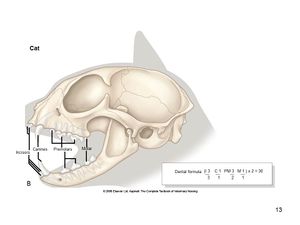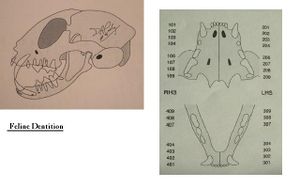Difference between revisions of "Dental Formula - Cat"
Jump to navigation
Jump to search
LisaMilella (talk | contribs) |
LisaMilella (talk | contribs) (→Molars) |
||
| Line 21: | Line 21: | ||
Image:Aspinall Slide13.JPG|<small>Image from [http://www.elsevierhealth.co.uk/veterinary-nursing/spe-60136/ Aspinall, The Complete Textbook of Veterinary Nursing], Elsevier Health Sciences, ''All rights reserved''</small> | Image:Aspinall Slide13.JPG|<small>Image from [http://www.elsevierhealth.co.uk/veterinary-nursing/spe-60136/ Aspinall, The Complete Textbook of Veterinary Nursing], Elsevier Health Sciences, ''All rights reserved''</small> | ||
Image:Feline Dentition.jpg|Feline Dentition - Copyright Nottingham 2008 | Image:Feline Dentition.jpg|Feline Dentition - Copyright Nottingham 2008 | ||
| − | |||
</gallery></center> | </gallery></center> | ||
{{OpenPages}} | {{OpenPages}} | ||
Revision as of 21:58, 28 July 2013
Introduction
Cats are toothless at birth. Deciduous teeth are complete and functional within 2 months of birth. Permanent teeth are complete and functional by the end of the 6th month.
The formula for deciduous teeth: 2 (i3/3 c1/1 p3/2)
The formula for permanent teeth: 2 (I3/3 C1/1 P3/2 M1/1)
Premolars
Cats are normally missing the maxillary 1st premolar and the mandibular 1st and 2nd premolars
Molars
A decrease in the number of molars leaves the cat with a shearing bite, rather than wider cusps for grinding.
Image from Aspinall, The Complete Textbook of Veterinary Nursing, Elsevier Health Sciences, All rights reserved
Error in widget FBRecommend: unable to write file /var/www/wikivet.net/extensions/Widgets/compiled_templates/wrt693abfffe4cfb0_85421189 Error in widget google+: unable to write file /var/www/wikivet.net/extensions/Widgets/compiled_templates/wrt693abfffeb5520_45494723 Error in widget TwitterTweet: unable to write file /var/www/wikivet.net/extensions/Widgets/compiled_templates/wrt693ac00002c052_28461999
|
| WikiVet® Introduction - Help WikiVet - Report a Problem |

